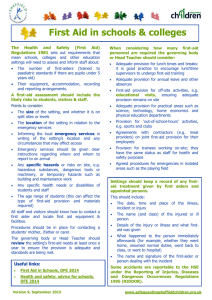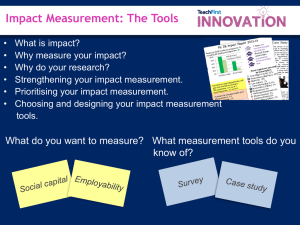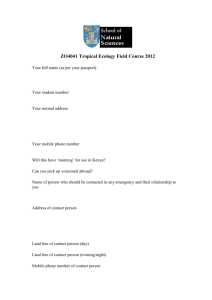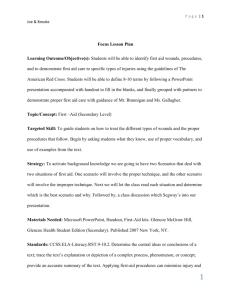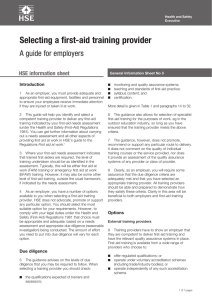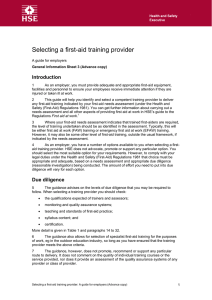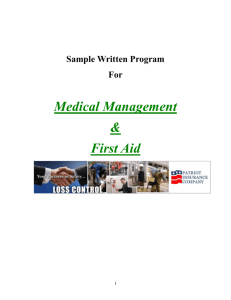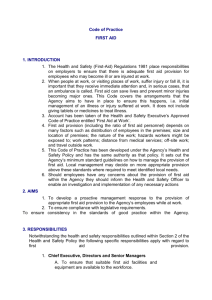First Aid Training - Hertfordshire Grid for Learning
advertisement
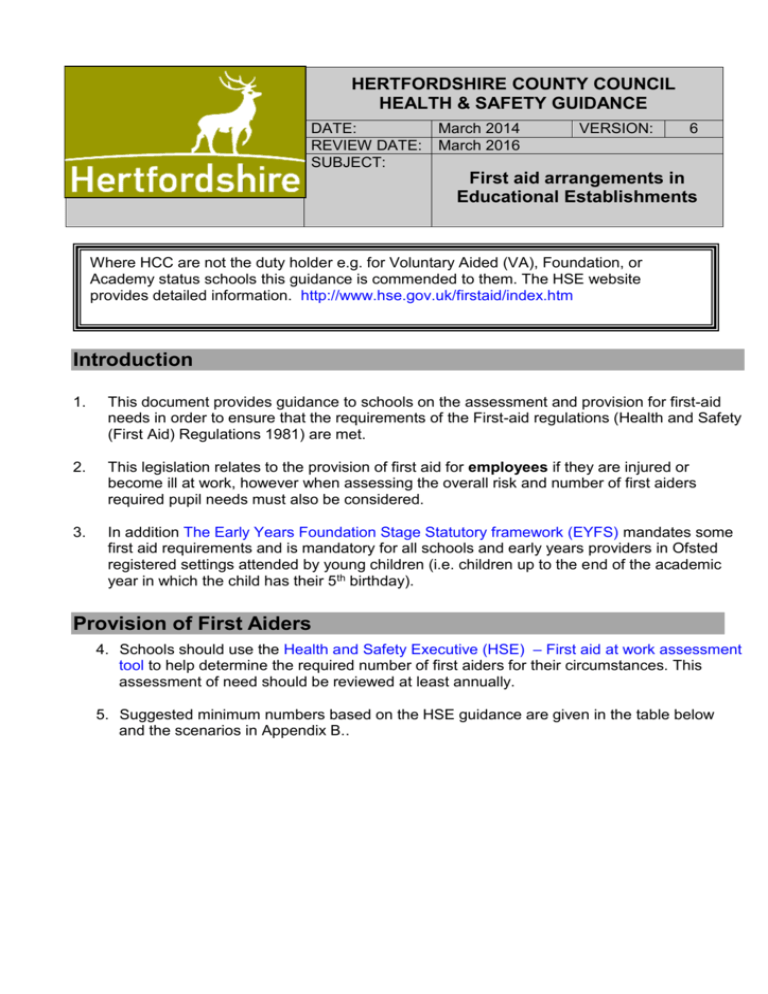
HERTFORDSHIRE COUNTY COUNCIL HEALTH & SAFETY GUIDANCE DATE: REVIEW DATE: SUBJECT: March 2014 March 2016 VERSION: 6 First aid arrangements in Educational Establishments Where HCC are not the duty holder e.g. for Voluntary Aided (VA), Foundation, or Academy status schools this guidance is commended to them. The HSE website provides detailed information. http://www.hse.gov.uk/firstaid/index.htm Introduction 1. This document provides guidance to schools on the assessment and provision for first-aid needs in order to ensure that the requirements of the First-aid regulations (Health and Safety (First Aid) Regulations 1981) are met. 2. This legislation relates to the provision of first aid for employees if they are injured or become ill at work, however when assessing the overall risk and number of first aiders required pupil needs must also be considered. 3. In addition The Early Years Foundation Stage Statutory framework (EYFS) mandates some first aid requirements and is mandatory for all schools and early years providers in Ofsted registered settings attended by young children (i.e. children up to the end of the academic year in which the child has their 5th birthday). Provision of First Aiders 4. Schools should use the Health and Safety Executive (HSE) – First aid at work assessment tool to help determine the required number of first aiders for their circumstances. This assessment of need should be reviewed at least annually. 5. Suggested minimum numbers based on the HSE guidance are given in the table below and the scenarios in Appendix B.. First Aid Category of Risk Numbers employed at any one location Lower Hazard fewer than 25 In school settings even where there are fewer than 25 staff then EFAW / a basic level of first aid training in order to meet pupil needs would be expected as a minimum. 25 -50 At least one first aider trained in EFAW more than 50 Higher Hazard1 5-50 more than 50 School settings where the EYFS framework applies N/A Suggested minimum number of First Aid Personnel within the school At least one first aider trained in first aid at work (FAW) for every 100 employed (or part thereof). At least one First Aider trained in EFAW or FAW depending on types of injuries that may occur. At least one additional First Aider trained in FAW for every 50 employed (or part thereof) At least one person who has a current paediatric first aid certificate (12 hours) must be on the premises at all times when children are present, and must accompany children on outings. 6. To ensure adequate coverage and quick accessibility to a first aider for both students and staff the following must also be considered: adequate provision in order to cover absence, leave, offsite activities etc; previous injuries / illnesses experienced; the layout of the premises e.g. split sites; the location of the school and remoteness from emergency services; any specific hazards on site (e.g. DT machinery, hazardous substances); numbers of pupils on site; extended / extra-curricular school activities. 7. Where the school site is shared (be that on a permanent or temporary basis) the first aid arrangements should be agreed by all employers and clearly communicated to employees. 8. In higher risk areas such as science, DT, PE etc. staff must be aware of immediate remedial measures in order to manage the initial injury and ensure an effective hand over of any specific information (particularly relating to chemical incidents) to the school first aiders. 9. Unless first aid cover is part of an employees contract of employment those who agree to become first aiders do so on a voluntary basis. 1 Schools will generally fall into the lower hazard category, although some areas of activity (i.e. DT, Swimming pool plant room, laboratories etc.) may fall into the higher risk category. CS Education Health and Safety Policy and Procedures Page 2 of 9 March 2014 Version 6 First Aid Specific Medical Needs 10. This document sets out to provide general guidance only, specialist advice should be sought for individuals with disabilities, long-standing medical conditions or allergies which may require special treatment in the case of accidents or illness. 11. The DfES Document Managing Medicines in schools and Early Years settings should be referred to for guidance in such situations. 12. A first-aid certificate does not constitute appropriate training in supporting children with medical conditions. The school nurse or other suitably qualified healthcare professional should confirm that staff are proficient before providing support to a specific child. 13. In addition some staff carry their own prescribed medication such as inhalers for asthma, insulin for managing diabetes etc. If an individual needs to take their own prescribed medication, the first aider’s role is limited to helping them do so and contacting the emergency services as appropriate. First Aid Training 14. Depending on the school’s size and assessment of need school first aiders should hold a valid certificate in either: 15. First aid at work (FAW) –a three-day course (18 hours); Paediatric first aid – a 2 day (12 hour) course to meet the requirements of the EYFS statutory framework; Emergency first aid at work (EFAW) – a one-day course (6 hours). To support the school’s appointed first aiders many training providers also offer Inset training in order to ensure basic first aid skills (applicable to both staff and pupils) are held by a wide number of other teaching and support staff, MSAs etc. 16. First aid training is valid for three years, after which a refresher course is required before recertification. An annual refresher is also available but this is not mandatory. 17. Schools should ensure that refresher training is undertaken before certificates expire and a record of first aiders and their certification dates should be maintained. 18. Whilst FAW first aiders can undertake the 2 day requalification course after the expiry date, in practice if over a month has elapsed since the certificate expired it would be prudent to undertake the full 3 day FAW course again. 19. As of 1st October 2013, the HSE no longer approves first aid training and qualifications. This training is available from a wide range of providers. Guidance on selecting a first aid provider is available from the HSE, this provides further detail on the criteria a competent provider should be able to demonstrate and checks which should be conducted when selecting a first aid training provider. 20. The voluntary aid societies (e.g. St.John Ambulance, British Red Cross) are recognised by the HSE as one of the standard setters in currently accepted first aid CS Education Health and Safety Policy and Procedures Page 3 of 9 March 2014 Version 6 First Aid practice. 21. Health professionals with the following training / experience are qualified to administer first aid without the need to hold a FAW or EFAW qualification. doctors registered with the General Medical Council; nurses registered with the Nursing and Midwifery Council; paramedics registered with the Health Professions Council. 22. Staff who administer first aid according to their training and in the course of their employment should be covered by employer’s liability insurance. 23. Automated External Defibrillators (AED) these are likely to be used very infrequently in a school environment and are more likely to be used on an adult than a pupil. Where defibrillators have been provided additional training in their use will be required. 24. First aid at work courses do not cover the use of defibrillators. Currently, courses are offered by the voluntary aid societies (e.g. St.John Ambulance, British Red Cross), voluntary rescue organisations and some statutory ambulance trusts. Whilst there is no prescriptive course programme, these organisations should be teaching the Resuscitation Council (UK) recommendations and using the learning outcomes as a framework. First Aid Equipment 25. All schools should have a minimum of one first aid kit, clearly marked, readily accessible and its location known by all staff and pupils. 26. Additional kits may then be needed for split sites, specific higher hazard areas (kitchens, DT workshops.etc.) and for offsite visits. 27. Travel first aid kits should be kept in minibuses or other such vehicles. 28. First aid kits should contain a sufficient quantity of suitable first aid materials and nothing else. See appendix A for a suggested list of minimum contents. 29. All first aid kits must be checked regularly and restocked by a designated member of staff, items should not be used after expiry date shown on packaging. Extra stock should be kept in the school. 30. First aid does not include the administration of medicines and thus first aid boxes should NOT contain drugs of any kind including paracetamol, antiseptic creams etc. 31. First aid arrangements must also be in place where school premises are used outside of ‘normal’ hours, e.g. for letting. Arrangements must be in place to ensure a first aid kit / telephone is available to persons who may require its use. 32. Where mains tap water is not readily available for eye irrigation, sterile water or sterile normal saline (0.9%) in sealed disposable containers should be provided. Each container should hold at least 300ml and should not be re-used once the sterile seal is broken. At least 900ml should be provided. Eye baths/eye cups/refillable containers should not be used for eye irrigation. CS Education Health and Safety Policy and Procedures Page 4 of 9 March 2014 Version 6 First Aid First Aid Rooms 33. The School Premises (England) Regulations 2012 require that every school have a suitable room that can be used for medical treatment / the short term care of sick and injured pupils when required. This area should be equipped with a sink, be reasonably near a WC. The room can be used for other purposes, except teaching, so long as it is readily available for medical use when needed. 34. Where a school caters for pupils with complex needs, additional medical accommodation must be provided which caters for those needs. Emergency Procedures 35. In the case of serious or potentially serious injuries, professional medical assistance should be sought at the earliest possible time so as to avoid the danger of inappropriate diagnosis or treatment. 36. Staff should not take children to hospital in their own car, it is safer to call an ambulance. A member of staff should accompany the child to hospital by ambulance and stay until parent or guardian arrives. Health professionals are responsible for decisions on medical treatment where a child’s parent or guardian is unavailable. Provision of Information 37. Schools should ensure that their first aid arrangements are detailed in their health and safety policy and that all staff are aware of these. These arrangements (including the location of equipment, facilities and personnel) should form part of induction training for all new and temporary staff. 38. There should be at least one notice posted in a conspicuous position within the premises, giving the location of first aid equipment and facilities and the name(s) and location(s) of the personnel concerned. Record Keeping 40. Schools should ensure the following records are available: Certification of training for all first-aiders and refresher periods; Any specialised instruction received by first-aiders or other staff (e.g. AED, Epi-pens); First aid cases treated (see accident / incident reporting). First Aid and Blood bourne viruses 41. First aid training courses should highlight the importance of preventing cross-infection in first-aid procedures. ‘Universal Precautions’ must always be followed to reduce the risk of transmitting blood borne infections such as hepatitis and HIV. 42. This approach assumes that all blood products and bodily fluids are potentially infectious thus the following procedures should always be applied: CS Education Health and Safety Policy and Procedures Page 5 of 9 March 2014 Version 6 First Aid Always cover any open wounds on your own hands with a waterproof adhesive dressing; Disposable gloves (unpowdered latex, nitrile or vinyl) to be worn when dealing with bleeding / cleaning up bodily fluids. 43. Small quantities of contaminated waste (soiled or used first aid dressings) can be safely disposed of via the usual refuse collection arrangements. Waste to be double bagged in plastic and sealed by knotting. Head Injuries 44. Injuries to the head need to be treated with particular care. High energy head injuries or those with any evidence of following symptoms may indicate serious injury and immediate medical advice should be sought. unconsciousness, or lack of full consciousness (i.e. difficulty keeping eyes open); confusion; irritability or altered behaviour (’easily distracted’, ‘not themselves’ ‘no concentration’, ‘no interest in things around them’) any problems with memory; persistent headache; blurred or double vision; vomiting; clear fluid coming from ears or nose; loss of balance; reading or writing problems; loss of power or sensation in any part of body, such as weakness or loss of feeling in an arm or leg; general weakness; seizure or fit. 45. NHS Direct provide full details of symptoms and treatment for minor head injuries http://www.nhs.uk/Conditions/Head-injury-minor/Pages/Symptoms.aspx 46. Where pupils receive a head injury their parents/carers should be informed, this should be done immediately by telephone if symptoms described above occur. For minor bumps the parent could be informed via letter, bumped head note etc. Further Information Further advice and information on first aid matters can be obtained from the Health and Safety Team on 01992 556478 healthandsafety@hertfordshire.gov.uk DfE good practice guide, Guidance on First Aid for Schools Please note information regarding first aid training providers in this advice is no longer current. DfE Pastoral care / first aid guidance http://www.education.gov.uk/schools/pupilsupport/pastoralcare/health/firstaid HSE First Aid homepage http://www.hse.gov.uk/firstaid/index.htm CS Education Health and Safety Policy and Procedures Page 6 of 9 March 2014 Version 6 First Aid APPENDIX A As a guide suggested contents lists for first aid kits are as follows: First aid kit Leaflet giving advice on first aid; Twenty individually wrapped sterile plasters (assorted sizes) appropriate to the work environment (which must be detectable for the catering industry); Two sterile eye pads; Two individually wrapped triangular bandages; Six safety pins; Six medium sized individually wrapped sterile unmedicated wound dressings (12x12cm); Two large sterile individually wrapped unmedicated wound dressings (18x18cm); At least 3 pairs of disposable gloves. Travel first aid kit Leaflet giving advice on first aid; Six individually wrapped sterile plasters (assorted sizes); Two individually wrapped triangular bandages; Two safety pins; Individually wrapped moist cleaning wipes; One large sterile unmedicated wound dressing (18x18cm); and Two pairs of disposable gloves. Disposable gloves should be vinyl, nitrile or powder free, low protein latex and CE marked. Blunt ended stainless steel scissors (minimum length 12.7 cm) may also be useful to cut clothing away. British Standard BS 8599 provides further information on the contents of workplace first-aid kits. Whether using a first-aid kit complying with BS 8599 or an alternative kit, the contents should reflect the outcome of the first-aid needs assessment. CS Education Health and Safety Policy and Procedures Page 7 of 9 March 2014 Version 6 First Aid APPENDIX B First-aid need assessment scenarios These case studies provide some scenario-based examples of first-aid needs assessments, they demonstrate the general principles involved but are not definitive and schools should not assume the outcomes shown are directly transferable to their situation. Primary school A primary school of 320 pupils also includes an attached preschool that takes children from the age of three. Across the site there are 26 staff on duty at any one time. The majority of hazards are considered low, although there is for example, a higher-hazard area in the on-site kitchen. The school is aware that four pupils have asthma and two hold Epi Pens. The first-aid needs assessment indicates that the suggested requirements are: First-aid personnel Required Yes/no Number needed First-aider with a first aid at work (FAW) certificate No N/A as there are less than 50 staff First-aider with an emergency first aid at work (EFAW) certificate Yes At least 1 on duty at all times while people are at work First-aider with additional training (specify) Yes Staff should also have training in any specific health care needs such as anaphylaxis. In addition to the EFAW training a minimum of 2 staff should be trained in paediatric first aid (12 hours) to satisfy the EYFS requirements. To support the appointed EFAW first aiders inset training has been provided to ensure key first aid skills are held by a wide number of other teaching and support staff, MSAs etc. Appointed person No N/A First-aid equipment and facilities Required Yes/no Number needed First-aid container At least 2 1 in the attached pre-school area and 1 in a central location easily accessible to the rest of the school (e.g school office). The food operator should also provide a first aid kit. Additional equipment (specify) (e.g. automated external defibrillator AED)) N/A N/A Travelling first-aid kit Yes Available for offsite visits First-aid / medical room Yes 1 CS Education Health and Safety Policy and Procedures Page 8 of 9 March 2014 Version 6 First Aid Secondary school A secondary school of 1588 pupils (11–18) is set in a rural area with a number of sports fields adjacent to the main site. It employs a part-time school nurse. There are 150 staff on site which are a mix of teachers, teaching assistants, technicians, catering, administrative and ground staff. There is a fleet of three school minibuses. Within the school there are potential high-hazard areas, i.e. laboratories, workshops and kitchens. The response times of the emergency services are within national guidelines. Typical hazards in such a workplace are trips and slips, burns, fractures and cuts. Some of the pupils have underlying health conditions such as eczema, asthma, diabetes and severe allergies or may be taking prescribed medication on a temporary or long-term basis. The first-aid needs assessment indicates that the suggested requirements are: First-aid personnel Required Number needed Yes/no First-aider with a first aid at work (FAW) certificate Yes At least 3 on duty at all times people are at work. First-aider with an emergency first aid at work (EFAW) certificate N/A N/A although these could be provided to support FAW provision First-aider with additional training (specify) Yes First-aiders should also have training in paediatric first aid and any specific health care needs such as anaphylaxis. PE staff have received training on the management of sports-related injuries. To support the appointed FAW first aiders additional training has been provided to ensure key first aid skills are held by a wide number of other staff. Appointed person No N/A First-aid equipment and facilities Required Yes/no Number needed First-aid container At least 3 In locations easily accessible to the whole school Additional equipment (specify) (e.g. automated external defibrillator AED)) AED May be required if number of pupils/staff with history of cardiovascular problems Travelling first-aid kit Yes At least 1 per minibus / available for offsite visits First-aid /medical room Yes 1 CS Education Health and Safety Policy and Procedures Page 9 of 9 March 2014 Version 6
